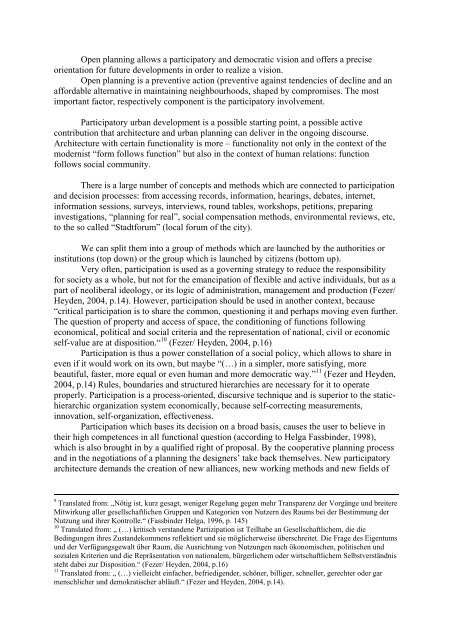HOW CAN PARTICIPATORY PRACTICES HAVE AN INPACT ON ...
HOW CAN PARTICIPATORY PRACTICES HAVE AN INPACT ON ...
HOW CAN PARTICIPATORY PRACTICES HAVE AN INPACT ON ...
You also want an ePaper? Increase the reach of your titles
YUMPU automatically turns print PDFs into web optimized ePapers that Google loves.
Open planning allows a participatory and democratic vision and offers a precise<br />
orientation for future developments in order to realize a vision.<br />
Open planning is a preventive action (preventive against tendencies of decline and an<br />
affordable alternative in maintaining neighbourhoods, shaped by compromises. The most<br />
important factor, respectively component is the participatory involvement.<br />
Participatory urban development is a possible starting point, a possible active<br />
contribution that architecture and urban planning can deliver in the ongoing discourse.<br />
Architecture with certain functionality is more – functionality not only in the context of the<br />
modernist “form follows function” but also in the context of human relations: function<br />
follows social community.<br />
There is a large number of concepts and methods which are connected to participation<br />
and decision processes: from accessing records, information, hearings, debates, internet,<br />
information sessions, surveys, interviews, round tables, workshops, petitions, preparing<br />
investigations, “planning for real”, social compensation methods, environmental reviews, etc,<br />
to the so called “Stadtforum” (local forum of the city).<br />
We can split them into a group of methods which are launched by the authorities or<br />
institutions (top down) or the group which is launched by citizens (bottom up).<br />
Very often, participation is used as a governing strategy to reduce the responsibility<br />
for society as a whole, but not for the emancipation of flexible and active individuals, but as a<br />
part of neoliberal ideology, or its logic of administration, management and production (Fezer/<br />
Heyden, 2004, p.14). However, participation should be used in another context, because<br />
“critical participation is to share the common, questioning it and perhaps moving even further.<br />
The question of property and access of space, the conditioning of functions following<br />
economical, political and social criteria and the representation of national, civil or economic<br />
self-value are at disposition.“ 10 (Fezer/ Heyden, 2004, p.16)<br />
Participation is thus a power constellation of a social policy, which allows to share in<br />
even if it would work on its own, but maybe “(…) in a simpler, more satisfying, more<br />
beautiful, faster, more equal or even human and more democratic way.” 11 (Fezer and Heyden,<br />
2004, p.14) Rules, boundaries and structured hierarchies are necessary for it to operate<br />
properly. Participation is a process-oriented, discursive technique and is superior to the statichierarchic<br />
organization system economically, because self-correcting measurements,<br />
innovation, self-organization, effectiveness.<br />
Participation which bases its decision on a broad basis, causes the user to believe in<br />
their high competences in all functional question (according to Helga Fassbinder, 1998),<br />
which is also brought in by a qualified right of proposal. By the cooperative planning process<br />
and in the negotiations of a planning the designers’ take back themselves. New participatory<br />
architecture demands the creation of new alliances, new working methods and new fields of<br />
9 Translated from: „Nötig ist, kurz gesagt, weniger Regelung gegen mehr Transparenz der Vorgänge und breitere<br />
Mitwirkung aller gesellschaftlichen Gruppen und Kategorien von Nutzern des Raums bei der Bestimmung der<br />
Nutzung und ihrer Kontrolle.“ (Fassbinder Helga, 1996, p. 145)<br />
10 Translated from: „ (…) kritisch verstandene Partizipation ist Teilhabe an Gesellschaftlichem, die die<br />
Bedingungen ihres Zustandekommens reflektiert und sie möglicherweise überschreitet. Die Frage des Eigentums<br />
und der Verfügungsgewalt über Raum, die Ausrichtung von Nutzungen nach ökonomischen, politischen und<br />
sozialen Kriterien und die Repräsentation von nationalem, bürgerlichem oder wirtschaftlichem Selbstverständnis<br />
steht dabei zur Disposition.“ (Fezer/ Heyden, 2004, p.16)<br />
11 Translated from: „ (…) vielleicht einfacher, befriedigender, schöner, billiger, schneller, gerechter oder gar<br />
menschlicher und demokratischer abläuft.“ (Fezer and Heyden, 2004, p.14).


